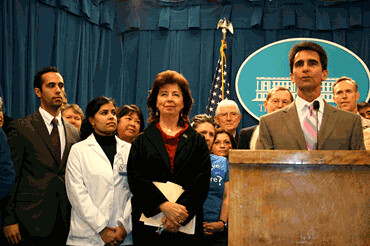As our favorite politicos fall all over each other to see who can further erode the healthcare package likely to emerge from Congress, it’s worth recalling that there is another way.
But first, get a glimpse of the latest fiasco moving forward in the Senate Finance Committee, where Max Baucus is leading the charge to develop the all important “bi-partisan” reform bill.
Today’s news is that “everyone’s smiling” — says Kent Conrad, author of the embarrassingly weak proposal for “non-profit coops” as an alternative to the public option, much less the real reform, single payer.
Why? Because they’ve found a way to cut the price tag by $400 billion. How?
largely by reducing the amount of subsidies for low-income individuals to buy insurance
Well, thank goodness. At least that means less public money going into the pockets of the already gorged insurance giants.
Too bad it means more people are likely to go bankrupt or self-ration needed care when Congress passes a bill forcing everyone to buy insurance with no meaningful limits on what the private insurers can charge.
Is there another route? Yes, and it’s not a secret.
The rest of the world has figured it out, as T.R. Reid reminds us in the forthcoming publication of “The Healing of America. A Global Quest for Better, Cheaper, and Fairer Health Care.” (Penguin Press) Essentially it’s the print version of the acclaimed Sick Around the World PBS show from last year.
By now, most people have heard how the U.S. ranked just 37th in the World Health Organization’s overall scorecard earlier this decade. Or how the Commonwealth Fund listed the U.S. last year as last among 19 industrial nations in preventable deaths.
But how about this one.
When the WHO assessed 191 countries on the barometer of “fairness,” the U.S. stumbled in at a bare 54th, barely beating out the impoverished African nations of Chad and Rwanda, but still behind Bangladesh and the Maldives. Not exactly a badge of honor.
Can we do better? Of course we can, says Reid, just by learning from the experiences of the rest of the world, especially those other comparable industrial nations which all have some form of national healthcare system — one in which their citizens’ health is not held hostage by profit-making private insurance companies. He concludes:
most rich countries have been national health statistics — longer life expectancy, lower infant mortality, better recovery rates from major diseases” than does the U.S. And they also perform better in presenting patients “a greater choice of doctors, hospitals, and procedures
For those who say we should not taint our borders by emulating France or Germany or Canada, Reid offers this retort:
We have borrowed numerous foreign innovations that have become staples of American daily life: public broadcasting, text messaging, pizza, sushi, yoga, reality TV, The Office, and even American Idol
Apparently we consider our health to be less important.
Reid also provides a useful service in knocking down most of the myths about other national systems that are common grist for the likes of Fox TV and the conservative think tanks.
Such as “they ration care with waiting list and limited choices;” in fact the data varies widely among other countries, and if you want to see really hideous waits, rationing of care, and limited choices, check out most American ERs and insurance network restrictions.
If there’s one crucial difference between the U.S. and all the other countries he surveyed, says Reid, it’s the moral dimension.
Whether a society should guarantee health care, the way we guarantee the right to think and pray as you like, to get an education, to vote in free elections? Or is medicine a commodity to be bought and sold, a product like a car, a computer, or a camera?
Apparently that is what makes our system “uniquely American.” As Reid puts it, “all the developed countries except the United States have decided that every human has a basic right to health care.”
And, that “no other country relies on for-profit insurance companies to pay for basic health care.”
President Obama who in 2003 notably described himself as a single payer advocate, now says it would be too disruptive to the present system to do that now. Well, a lot of people believe our dysfunctional, profit-focused healthcare system needs some good disruption.
And, there’s plenty of examples abroad that you can remake your healthcare system, and make it better, as a number of industrial countries did in the wreckage after World War II.
There’s a more recent example, Taiwan, which in 1994 scrapped its own broken system and adopted a single payer approach similar to Canada.
Almost overnight, Reid notes, every resident of Taiwan, in their new national single payer system, had complete choice of provider, cut administrative costs to a mere 2 percent, and experienced striking improvements in patient outcomes.
While Taiwan, like some other national systems, has some problems today, mostly with underfunding, it has a much more equitable healthcare infrastructure, and guarantees healthcare coverage for everyone.
With immensely more resources than other nations, there’s no reason we couldn’t learn from their successes, their mistakes, and adopt a national system that would be far more humane than the disaster we have now.

